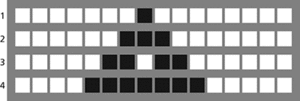Abstract computational systems based on arrays or grids of simple cells, the contents of which range over a small number of values that change over time depending on the current values in any given cell and its immediate neighbours. Arrays are typically one- or two-dimensional. Such a system is initialized by setting starting values into all the cells. A generation step is the process of applying the rules for value changes to every cell simultaneously. Once initialized, generation steps are applied repeatedly and the changes to the cell values are observed. The kinds of behaviour that are observed depend in complex ways on the range of values for each cell, which cells are considered as neighbours, and the precise rules chosen. It has been shown that a one-dimensional cellular automaton, with only two cell values ‘on’ and ‘off’, and a suitable change rule can model general computing. See also Turing machine.
An agent-based model that works on a two-dimensional lattice grid, where the state of any cell is related to that of its neighbours. At its simplest, a grid of elementary cellular automata consists of a one-dimensional row of cells, where each cell can be in one of two states, and the rules for the transformation of a cell are based on the current state of the cell and its two closest neighbours. The neighbourhood thus consists of three cells [6, 7, 8].
In this example, the two states are called ‘white’ and ‘black’, and the rules might be that:
• If all three cells are white, the cell remains white
• If all three cells are black, the cell becomes white
• In any other case (that is, if there is a mixture of black and white cells in the neighbourhood), the cell becomes (or remains) black.
The diagram shows four successive generations of cellular automata conforming to these rules: an initial generation consisting of one black cell with all other cells white, and three subsequent generations created by three applications of the rules.
• Parallelism: The cells all change state independently and simultaneously (that is, in parallel)
• Locality: The new state of a cell is dependent on only the state of the cell itself and the states of its neighbours
• Homogeneity: All cells have an identical set of possible states and follow the same rules.

Cellular automata
http://www.mjyonline.com/CellularAutomataUses.htm Website with clear and useful explanations on cellular automata and on which the example is based.
http://uncomp.uwe.ac.uk/genaro/Cellular_Automata_Repository/Software.html A variety of cellular automata can be found at this website.
- circline
- circuit
- circuit board
- circuit-breaker
- circuit card
- circuit diagram
- circuit loop
- circuit loop analysis
- circuit mesh analysis
- circuit of capital
- circuit switched network
- circuit switching
- circular argument
- circular birefringence
- circular data
- circular dichroism
- circular dichroism spectroscopy
- circular distribution
- circular flow of income
- circular function
- circular histogram
- circularity index
- circularity ratio
- circularization
- circular list